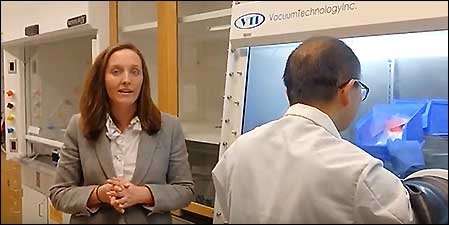
The race to produce safe, powerful and affordable solid-state lithium batteries is accelerating and recent announcements about game-changing research using a solid non-flammable ceramic electrolyte known as garnet has some in the race calling it revolutionary.
“This is a paradigm shift in energy storage,” said Kelsey Hatzell, assistant professor of mechanical engineering. A paper – “The Effect of Pore Connectivity on Li Dendrite Propagation Within LLZO Electrolytes Observed with Synchrotron X-ray Tomography” – describing her novel research on the failure points of a garnet electrolyte was published online in March in the American Chemical Society’s Energy Letters, which was among the most read ACS Letters articles that month.
Lithium-ion batteries typically contain a liquid organic electrolyte that can catch fire. The fire risk is eliminated by the use of a non-flammable garnet-based electrolyte. Replacing liquid electrolytes with a solid organic like garnet also potentially lowers the cost by increasing battery life.
“Solid-state batteries are desirable for all-electric vehicles and other applications where energy storage and safety are paramount,” Hatzell said.
Hatzell’s team tested Li7La3Zr2O12 – Lithium lanthanum Zirconium Oxide or LLZO – a garnet-type material that shows great promise for all-solid-state battery applications due to its high Li-ion conductivity and its compatibility with Li metal.
“Understanding the failure mechanisms within these electrolyte systems is critical for designing resilient solid electrolyte systems,” said Hatzell. “The primary limitation of LLZO is the propensity for short-circuiting events at low current densities.”
Hatzell’s study tracks structural changes in LLZO after realistic charging and discharging events using synchrotron X-ray tomography. This technique allows the researchers to look inside the battery and view 3D structural features with sub-micron resolutions.
“Most techniques that image lithium in a solid electrolyte are done destructively or ex situ using scanning electron or optical microscopy techniques. Testing the material under more realistic conditions using synchrotron tools allows us to probe buried interfaces,” said Hatzell, whose co-authors are Fengyu Shen, a postdoctoral scholar, and graduate students Xianghui Xiao and Marm Dixit.
“There are only a handful of synchrotrons and neutron sources that exist in the world. Marm was one of 60 graduate students selected for the 2017 National School on Neutron and X-ray Scattering. “As a part of this program he spent one week at Oak Ridge National Lab and one week at Argonne National lab,” Hatzell said.
Argonne’s Advanced Photon Source and ORNL’s Spallation Neutron Source and High Flux Isotope Reactor allow nanoscale study of advanced materials and interactions. Dixit was able to work and learn synchrotron characterization techniques from leading scientists and experts. Hatzell’s team conducted all of its testing at Argonne.
“These results can potentially inform materials design for the next generation of all solid-state battery systems. The results concluded that the presence of voids or connected pores led to a higher failure rate,” Hatzell said.
“While there is still a lot of research to be done to bring solid state devices to the market, their promise for applications in high-energy density batteries and electric vehicle applications is stirring a lot of interest across the globe.”
